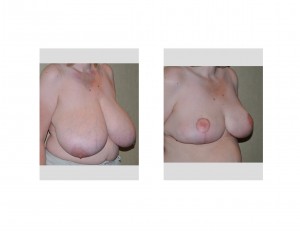Background: Breast reduction remains one of the most common reconstructive plastic surgery procedures. It provides not only reduction in the size of a large breast but it also lifts and reshapes it as well. The amount that the breast is reduced or how much it is lifted is based on patient preference and what the breast tissues will allow.
In the most traditional and commonly used breast reduction method, known as the inferior pedicle technique, the operation is based on maintaining survival of the nipple-areolar complex. The nipple remains attached to the breast tissues and the excessive breast tissue is removed around the base or sides of the breast mound. This way the blood supply to the nipple coming up from the underlying chest muscle remains intact ensuring its survival and function after surgery.
But when the breast is very large and hangs down low on one’s stomach, the breast tissues which are attached to the nipple (known as the pedicle) becomes very long. Reducing and lifting such a large breast increases the risk of kinking or cutting off the blood supply to the nipple. Furthermore, in an effort to keep the pedicle as thick as possible to prevent nipple survival problems, the amount that the breast can be reduced is much less.
An alternative breast reduction method in extremely large breasts is the free nipple grafting technique. In this procedure, the desired size of the nipple-areolar complex is first removed, the breast reduced to any desired size, and the nipple put back as a full-thickness skin graft at the end of the operation. This method allows great versatility in size reduction without concerns about nipple survival afterwards. There is the issue of how well the nipple graft will survive, identical to any skin graft take.



Case Highlights:
1) Breast reduction is a highly successful procedure regardless of breast size. In reduction of very large breasts, the risk of nipple loss is increased.
2) The free nipple grafting breast reduction technique is useful in very large breast reductions and avoids the risk or partial or complete nipple necrosis.
3) Free nipple grafts will not have feeling or nipple erectile or lactation capability. They will also have changes in pigmentation and nipple projection.
Dr. Barry Eppley
Indianapolis, Indiana


